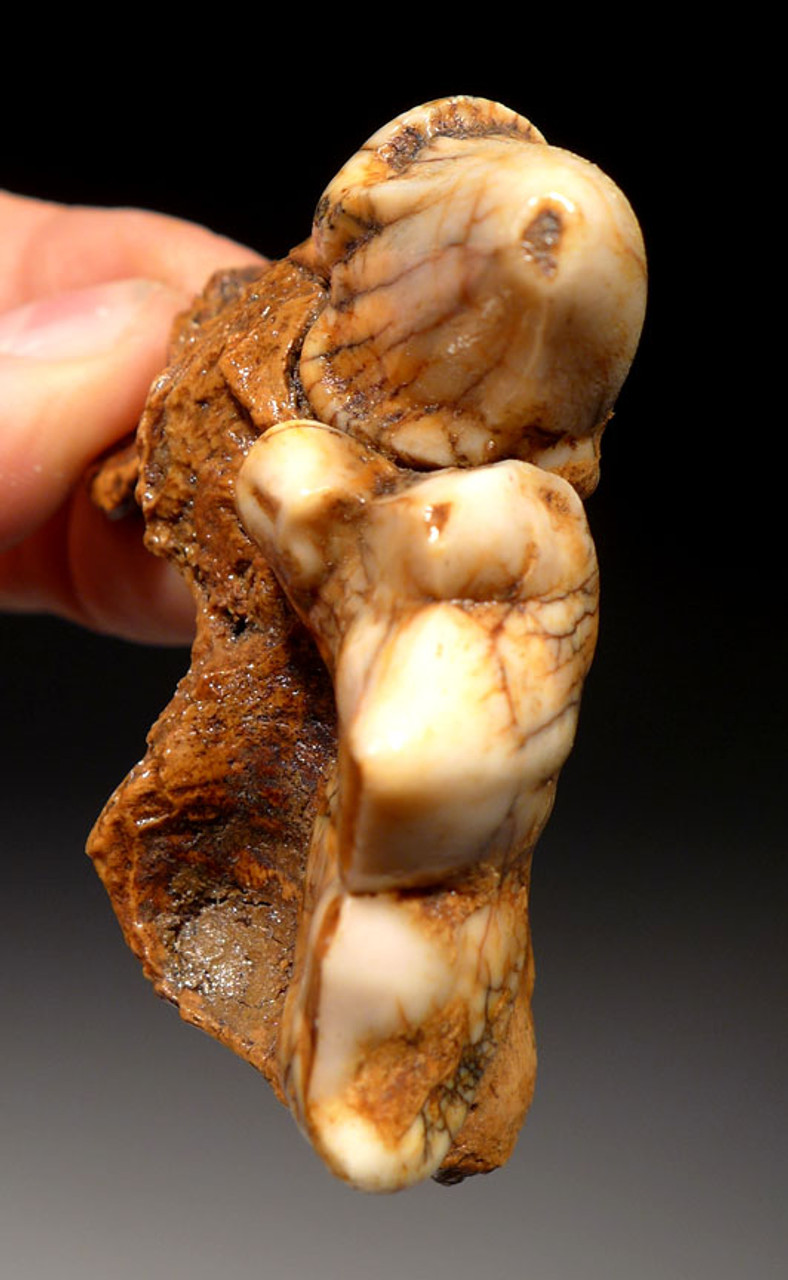Product Description
ID
|
Crocuta crocuta spelaea
|
||
FOUND
|
Cave Deposit
|
||
AGE
|
PLEISTOCENE: 400,000 - 20,000 years
|
||
SIZE
|
Right side 4.25" long,
|
||
CONDITION
|
FROM THE SAME SKULL
|
||
NOTE
|
PERFECTLY PRESERVED!!! ONE OF
|
||
INCLUDES DISPLAY BOX - Actual Item - One Only
|
|||
Fossils of the Giant European Cave Hyena Crocuta spelaea, are an EXTREMELY RARE find. With stringent collecting and digging laws in place now throughout Europe where the Giant Cave Hyena is found, new finds are not possible as prospecting is now illegal and strictly enforced. Besides, prior to collecting laws, most of these cave deposits had been virtually cleaned out of their fossils by intense digger activity. Even if you could legally explore caves in Europe today and search for such fossils, a find such as this is a thing of the past.
The Giant European Cave Hyena, Crocuta crocuta spelaea was one of most dangerous and powerful of apex predators in the last Ice Age. When the rare opportunity presents itself such as this offering, collectors should strongly consider taking advantage of such an opportunity to add a specimen of this beast to their collection.
FROM THE SAME SKULL AND ANIMAL - this is a RIGHT MAXILLA AND LEFT MAXILLA (minus the left canine tooth) from a Cave Hyena from the Carpathian Mountains of Romania. It comes from a 45 year Belgian private collection. The MASSIVE bone-crushing molars shows just how amazingly powerful this beast was. The preservation is STUNNING with complete, colorful displays in the bone and teeth. Both are intact as it was found with NO REPAIR OR RESTORATION.
Recent scientific studies reveal a fascinating and brutal former world that existed in the last Ice Age of Europe where Cave Hyenas hunted and fed on other Cave Hyenas, Cave Bears, Cave Lions and even humans such as Neanderthals and Cro-Magnons. Fossils of the Cave Hyena are immeasurably more rare than any saber cat material including Smilodon!
The Giant European Cave Hyena (Crocuta crocuta spelaea, aka Hyaena spelaea) first appeared in Europe around 500,000 years ago and lived up to the near close of the last European Ice Age. They coexisted with primitive humans such as Neanderthals and Cro-Magnon man and prehistoric European cave paintings have been found depicting these beasts with spots. Certainly, these beasts were feared and avoided at all costs due to the danger of an unfortunate meeting. The spots offer an insight to what they may have looked like and scientists agree that the closest living relative to the Giant European Cave Hyena is the African Spotted Hyena. Fossil remains discovered in Great Britain and Alpine regions indicate these locations were home to the largest of the Giant Cave Hyenas.
The Giant European Cave Hyena stood was very large measuring close to 40 inches high at its shoulders. It weighed anywhere from 175 to up to 285 pounds. These animals were nocturnal apex predators that lived in caves and reared their young there, as well. They hunted in packs of 10 to 25 animals. They also scavenged on carrion at all opportunities. Cave floor deposits where these beasts inhabited indicate a varied diet of deer, boar, horse, bison, woolly mammoth and woolly rhino. Some deposits of former Cave Hyena dens have even produced partially eaten Neanderthal remains indicating that these beasts even preyed on humans. Like the African Spotted hyenas of today, it is likely that the Giant European Cave Hyena had the most complex social structure of ALL non-primate species known!
 US DOLLAR
US DOLLAR
 EURO
EURO
 AUSTRALIAN DOLLAR
AUSTRALIAN DOLLAR
 CANADIAN DOLLAR
CANADIAN DOLLAR
 POUND STERLING
POUND STERLING
































